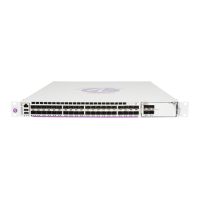VRRP
7705 SAR OS Router Configuration Guide 221
VRRP Priority Control Policies
VRRP supports control policies to manipulate virtual router participation in the VRRP master
election process and master self-deprecation. The local priority value for the virtual router
instance is used to control the election process and master state.
This section contains information on the following topics:
• VRRP Policy Constraints
• VRRP Base Priority
• VRRP Priority Control Policy In-use Priority
• VRRP Priority Control Policy Priority Events
VRRP Policy Constraints
Priority control policies can only be applied to non-owner VRRP virtual router instances.
Owner VRRP virtual routers cannot be controlled by a priority control policy because they
must have a priority value of 255 that cannot be lowered. Only one VRRP priority control
policy can be applied to a non-owner virtual router instance.
Multiple VRRP virtual router instances can be associated with the same IP interface, allowing
multiple priority control policies to be associated with the IP interface.
An applied VRRP priority control policy only affects the in-use priority on the virtual router
instance if the preempt mode has been enabled. A virtual router instance with preempt mode
disabled always uses the base priority as the in-use priority, ignoring any configured priority
control policy.
VRRP Base Priority
The base priority is the starting priority for the VRRP instance. The actual in-use priority for
the VRRP instance is derived from the base priority and an optional VRRP priority control
policy.
The base priority is used to derive the in-use priority of the virtual router instance as modified
by any optional VRRP priority control policy. VRRP priority control policies are used to
either override or adjust the base priority value depending on events or conditions within the
chassis.

